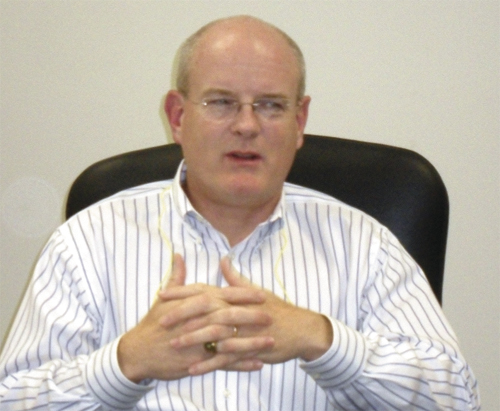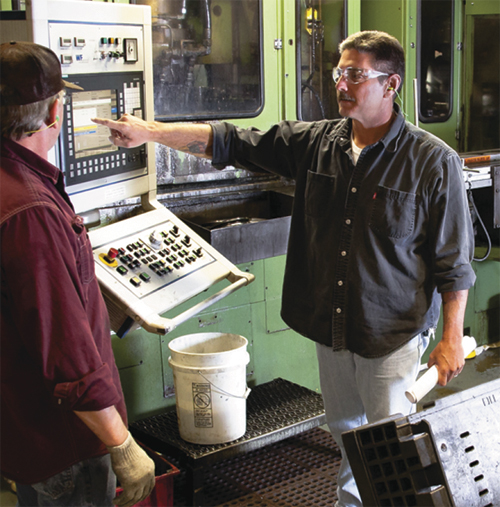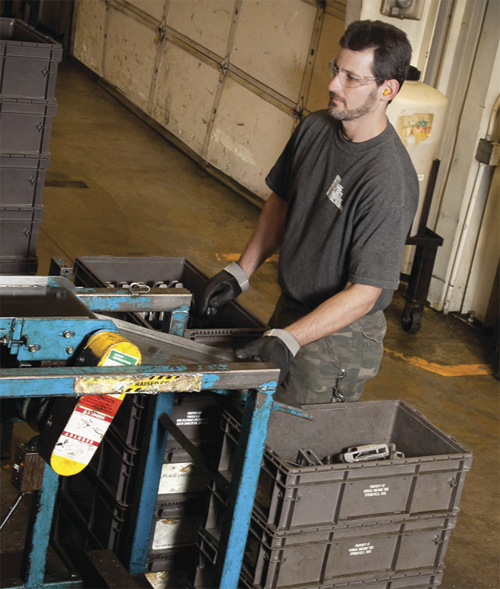Skills Had to be Addressed
Located in Southwestern Ohio, McGregor Metalworking once had its pick of experienced workers. Over time, those workers aged, bringing competition for new hires and creating the need to prevent quality associates from taking their talents elsewhere. Just as importantly, as McGregor Metalworking expanded, it began to teach basic and advanced skills to bring associates up to speed on new equipment and technologies. “Metalworking skills are not transferring in the traditional ,” says Belden.
(Photo by Brock Cox)
At one time, skills were learned on the job, with older, seasoned employees helping newer hires. Employees became more familiar with equipment and processes, and learned tips and tricks from the more experienced personnel. In recent years, Belden explains, the workforce has become more transient. Experienced tool and die workers retired or lost their jobs during downturns, the same with machine operators. Now, a dearth of skills in the pool of potential employees makes training all the more important. Pay for Skills addresses these challenges.
“We talk a lot about our centers of excellence, but the equipment is only a small part of it,” says Belden. “These machines don’t run themselves, and workforce development is our competitive advantage.”
Pay for Skills Provides Paths to Success
McGregor Metalworking’s Pay for Skills plan compensates employees based on their level of training. Under this plan, hourly employees are paid solely on the basis of their skills, without regard to length of service. Training coordinators work with supervisors to coordinate training activities, ensuring that each employee reaches his maximum skill level. A path of training has been created for all production-related employees, taking them from new-hire status through each level of training. Paths include press operation, material handling, secondary-machine operation, quality, material services, pulley spinning, resistance welding, robotic welding and assembly.
Progression to higher training levels brings automatic pay adjustment. A press operator, for example, after achieving Level Four training that can be accomplished within 3.5 yr., will earn 40 percent more than his starting wage.
In addition, achievement of Level Four qualifies an employee for National Institute for Metalworking Skills (NIMS) Level III credentials, upon passing the applicable tests; this also earns a pay raise. That is significant, as NIMS is the only measure of standardization for employee training in manufacturing. McGregor Metalworking, the only NIMS-accredited metalforming company, according to Belden, offers other benchmarks along its Pay for Skills paths that enable associates to earn NIMS Level I and II credentials. More than 60 percent of the company’s production associates carry NIMS credentials.“We talk to local human resources groups to benchmark our company,” says Belden, “and based on that our pay scale and benefits outperform similar businesses.”
McGregor Metalworking’s training program begins with entry-level safety training, accomplished prior to an employee’s first day of employment. Next comes a new-hire orientation—5 to 6 hr. of in-depth training on site-specific safety issues and state and federal requirements. Employees then embark on training paths depending on their particular jobs. All employees must pass written and hands-on performance assessments in order to move on.
The job paths also offer something unique in manufacturing—college credits. Graduates of the company’s Pay for Skills program receive 40 credit hours, to be used toward an Associate of Technical Studies certificate or a degree in Manufacturing Operations at nearby Clark State Community College.
Training Staff Provides Individual Instruction
While McGregor Metalworking embraces employee training and workforce development, many other companies shy a from the practice, fearful of spending time and money on employees only to see them take their valuable company-paid skills and head elsewhere. That is the wrong approach.
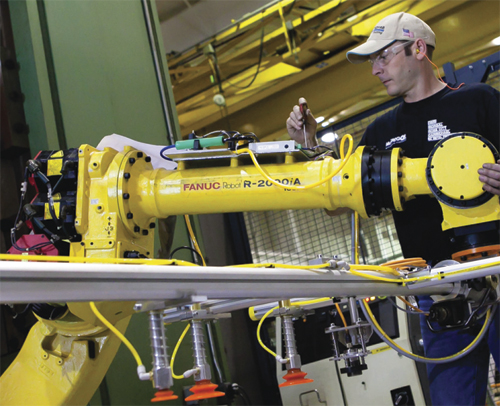
Tod Kuss performs maintenance on a robotic manipulator at OSMI Engineering. (Photo by Brock Cox)
“The one thing worse than training someone and having him leave is not training someone and having him stay,” says Roger Sigman, one of two full-time training coordinators at McGregor Metalworking.
Sigman and Dave Buxton, the firm’s other training coordinator and a special projects manager, handle Pay for Skills training for some 50 employees, primarily at the Morgal and Rose City facilities. As training coordinator, Buxton provides training in his area of expertise, metal-stamping presses, as well as satellite processes. In press operator training, Pay for Skills begins with an introduction to the process, including how the paths and levels work, how pay rises with each training level achieved and how trainees can accomplish skill-level increases.
“From there we allot about an hour per week per student for formalized training,” Buxton explains.Trainers work with trainees until each lesson has been mastered—no one fails.
“Training start and finish lines are the same,” Buxton says, “but the time taken to reach the finish line can differ for each associate.”
Adds Jeff Powell, Ohio Stamping & Machine general manager and one of the developers of McGregor Metalworking’s Pay for Skills program, introduced in the mid-1980s: “As associates climb the training ladder, our Pay for Skills program ensures that everyone is trained to the same level of expertise and performs tasks in the same manner.”
Completion of Level One Pay for Skills training is a requirement for employment, but associates don’t have to continue with succeeding levels.
Why would associates abandon training and forgo the opportunities it provides?
“Some associates are intimidated by the educational process,” says Powell. “They fear formal education and testing, and fear failure. We explain that with our system you can’t fail.”
Pay for Skills demands commitment on the part of the associate, and the company continuously shows its commitment, even in tough times.
“2009 was a terrible year for manufacturing and a terrible year for us,” recalls company chairman Dan McGregor. Noting that in 2009 the company did not realize a profit, McGregor says that it invested 9025 hours in training at a cost of about $175,000.
“We had to reduce staff,” McGregor continues, “but we still invested in our remaining associates when manufacturers were just cutting. We made sure we were ready for 2010 and beyond.”
McGregor, in fact, was ready for 2010, and the investment in associates has been remarkable. Consider that in 2009, the company had 223 employees. By 2011 the roster had expanded to 353.
Workforce Development Pays Dividends
The benefits of a higher-skilled workforce has boosted business at McGregor Metalworking, and proved that training and success go hand-in-hand.
“For years we have been making parts for one of our fitness-industry customers,” says Dan McGregor. “In 2008, some of our associates visited the customer’s facility and witnessed construction of a treadmill frame, and learned how to produce the assembly more efficiently. Over the course of 18 months we worked with that customer to redesign the treadmill base as a weldment rather than as several parts bolted together. Normally, to produce this assembly we would have stamped parts at Ohio Stamping & Machine and Morgal, and transfer the parts to Rose City for welding. The redesign, however, consisted of more than 50 parts and a final assembly weighing 140 lb. So rather than move all of those parts across three locations, we decided to grow our welding expertise at Morgal and purchased welding equipment to take on that work. Then we identified a press operator who showed the skills and commitment to be a weld group leader and put him through training. We eventually built the entire weld department at Morgal from scratch, and today we produce that assembly here and ship it to the customer daily.”
That speaks to the power of training, and McGregor has flexed its training muscle to further develop cellular manufacturing to serve that same fitness customer. Three welding systems at Morgal sit side by side, with a motor pan produced in one of the systems and rails in another. A manipulator moves the subassemblies to the third welding system for final assembly.
Taking Skill-Building on the Road
(Photo by Brock Cox)
Training at South Carolina Metal Products (SCMP) also has paid dividends, creating a new skilled workforce and providing big business for an automotive Tier One. In 2006, McGregor Metalworking opened a plant in Aiken, SC, located close to the customer but without a manufacturing-skilled workforce from which to draw.
“The plant resides in what is primarily an equestrian-based community,” says Belden. “As a result we recruited inexperienced people and undertook a massive effort to train and retain a skilled workforce. The plant initially performed primarily welding, and recently has transitioned to stamping. At that point we needed an extensive knowledge of stamping in the pressroom on two shifts.
“We needed expertise at SCMP,” he continues, “because that Tier One is probably our most demanding customer from a quality standpoint.”
With stamping equipment still being installed, McGregor hired seven press operators and brought them to Springfield for training.
“These new employees spent every morning at one of our Springfield plants and every afternoon in a classroom,” recalls Sigman.
Variety of Operations Allows Successful Inhouse Promotion
Company culture at McGregor Metalworking supports promotion from within the ranks. Though some caution that filling slots from the inside prevents fresh eyes and fresh ideas, the diversity of McGregor Metalworking’s processes, coupled with multiple facilities, negate such concerns.
“There’s a view that by promoting from within all the time, you don’t receive an outside view of things,” says Belden. “We have an advantage because we are a conglomerate of five separate companies. We move associates from company to company on a regular basis, providing fresh sets of eyes.”
Also, as some McGregor Metalworking operations may experience downturns, other locations can pick up the slack and provide a new home for associates.
Long-Term Professional Growth
It boils down to this: McGregor Metalworking’s workforce development plans benefit the organization, and allow associates to pursue long-term professional growth.
“When we first developed Pay for Skills, workers could leave our business or any other business, walk down the street and find a new job that same day,” says Powell. “We were bringing in new employees, and current employees were leaving, but we weren’t working to turn jobs into careers. Today, there isn’t a pool of people out there that have the knowledge and can just pick up and leave, and there aren’t the opportunities to simply travel from one job to the next.
“When we find a potential employee with a bit of that knowledge and the willingness to succeed,” Powell continues, “Pay for Skills lets us train them for a long-term career. Think about it—where can you go today, and in a 4-yr. timeframe gain the monetary increases, build the foundation for a solid future, train on company time and have the opportunity to get a college degree? Our Pay for Skills provides that.” MF
Case Study: Pridgeon & Clay, Grand Rapids, MI
Case Study: E.J. Ajax and Sons, Fridley, MN
Technologies: Management, Quality Control, Training







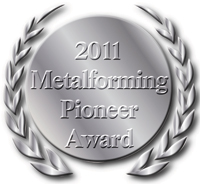 In 1965, John McGregor acquired Morgal Tool & Die, a business focused on manufacturing tools and dies. Forty-six years later, the McGregor family presides over five manufacturing facilities, known collectively as McGregor Metalworking Companies. Springfield, OH, is home to four, with a fifth located in South Carolina.
In 1965, John McGregor acquired Morgal Tool & Die, a business focused on manufacturing tools and dies. Forty-six years later, the McGregor family presides over five manufacturing facilities, known collectively as McGregor Metalworking Companies. Springfield, OH, is home to four, with a fifth located in South Carolina. 